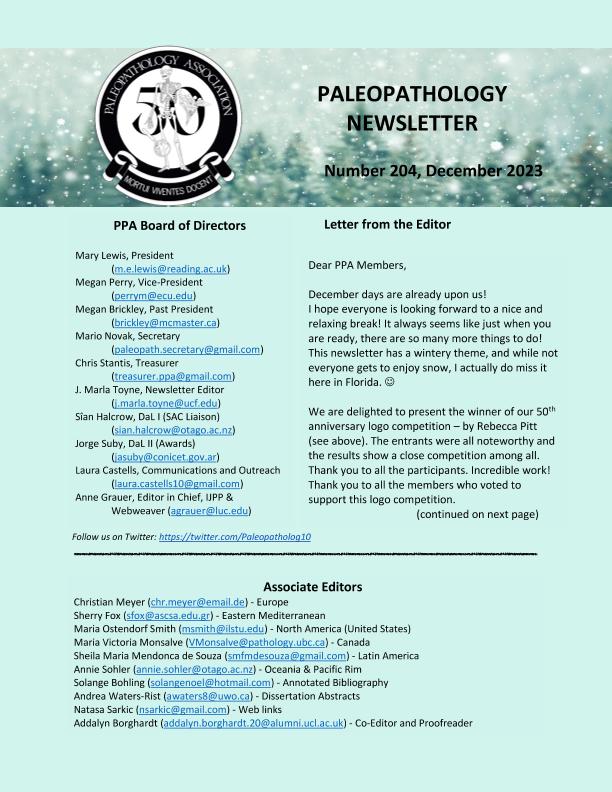Mostrar el registro sencillo del ítem
dc.contributor.author
Guevara Batllori, María Daniela

dc.contributor.author
Novellino, Paula Silvana

dc.contributor.author
Acosta, Candela
dc.contributor.author
Tessone, Augusto

dc.contributor.author
Da Peña Aldao, Gabriela Verónica

dc.contributor.author
Barberena, Ramiro

dc.date.available
2024-04-10T13:03:55Z
dc.date.issued
2023-12
dc.identifier.citation
Guevara Batllori, María Daniela; Novellino, Paula Silvana; Acosta, Candela; Tessone, Augusto; Da Peña Aldao, Gabriela Verónica; et al.; Metabolic stress and diet, a comparative case study in Mendoza (Argentina) during the final late Holocene; Paleopathology Association; Paleopathology Association Newsletter; 204; 12-2023; 18-28
dc.identifier.issn
0148-4737
dc.identifier.uri
http://hdl.handle.net/11336/232626
dc.description.abstract
Objective: Study the metabolic stress on the skeletal remains of two populations from Mendoza (Argentina) selected based on economic differences. Firstly, the hunter-gatherer population (A) from site B6 (2400-2200 years BP) in the eastern plains, which has an abundant intake of C3 due to the presence of wild plants and animals. Secondly, population (B) from the Potrero Las Colonias site (650-500 years BP), in the highland Andean valleys, which has a predominant C4 intake due to intensive maize agriculture.Materials and Methods: We recorded the presence/absence, degree of severity and stage of healing status and severity of Porotic Hyperostosis (PH) and Cribra Orbitalia (CO).Results: We record high percentages of PH for the farmer population B (88%) compared to population A (32%) and low percentages of CO in both samples. A severe degree of lesion and the presence of active healing was recorded only in the farmers, while mild degree of severity and mixed stages of healing prevail in the hunter-gatherers.Discussion: The isotopic data shows different scenarios in terms of economic organization, which, together with the results presented above, allows the suggestion that the farmers (B) may have had deficient nutrition compared to the hunter-gatherers (A). This generated a greater exposure to systemic stress events (e.g. adverse climatic factors) and caused metabolic alterations contributing to the more frequent formation of lesions. Since this may have been due to larger risks associated to sedentary traditional farming in drylands compared to mobile hunter-gatherer organization, this discussion relates to global debates on diet and health during the transition to productive economies.
dc.format
application/pdf
dc.language.iso
eng
dc.publisher
Paleopathology Association
dc.rights
info:eu-repo/semantics/openAccess
dc.rights.uri
https://creativecommons.org/licenses/by-nc-sa/2.5/ar/
dc.subject
METABOLIC STRESS
dc.subject
MENDOZA
dc.subject
LATE HOLOCENE
dc.subject.classification
Arqueología

dc.subject.classification
Historia y Arqueología

dc.subject.classification
HUMANIDADES

dc.title
Metabolic stress and diet, a comparative case study in Mendoza (Argentina) during the final late Holocene
dc.type
info:eu-repo/semantics/article
dc.type
info:ar-repo/semantics/artículo
dc.type
info:eu-repo/semantics/publishedVersion
dc.date.updated
2024-03-13T13:44:46Z
dc.journal.number
204
dc.journal.pagination
18-28
dc.journal.pais
Estados Unidos

dc.description.fil
Fil: Guevara Batllori, María Daniela. Consejo Nacional de Investigaciones Científicas y Técnicas. Centro Científico Tecnológico Mendoza. Museo de Ciencias Naturales y Antropológicas J. Cornelio Moyano; Argentina
dc.description.fil
Fil: Novellino, Paula Silvana. Consejo Nacional de Investigaciones Científicas y Técnicas. Centro Científico Tecnológico Mendoza. Museo de Ciencias Naturales y Antropológicas J. Cornelio Moyano; Argentina
dc.description.fil
Fil: Acosta, Candela. Consejo Nacional de Investigaciones Científicas y Técnicas. Centro Científico Tecnológico Mendoza. Museo de Ciencias Naturales y Antropológicas J. Cornelio Moyano; Argentina. Universidad Nacional de Cuyo. Facultad de Filosofía y Letras. Instituto de Arqueología y Etnología; Argentina
dc.description.fil
Fil: Tessone, Augusto. Consejo Nacional de Investigaciones Científicas y Técnicas. Oficina de Coordinación Administrativa Ciudad Universitaria. Instituto de Geocronología y Geología Isotópica. Universidad de Buenos Aires. Facultad de Ciencias Exactas y Naturales. Instituto de Geocronología y Geología Isotópica; Argentina
dc.description.fil
Fil: Da Peña Aldao, Gabriela Verónica. Consejo Nacional de Investigaciones Científicas y Técnicas. Centro Científico Tecnológico Mendoza. Museo de Ciencias Naturales y Antropológicas J. Cornelio Moyano; Argentina
dc.description.fil
Fil: Barberena, Ramiro. Consejo Nacional de Investigaciones Científicas y Técnicas. Centro Científico Tecnológico Conicet - Mendoza. Instituto Interdisciplinario de Ciencias Básicas. - Universidad Nacional de Cuyo. Instituto Interdisciplinario de Ciencias Básicas; Argentina. Universidad Católica de Temuco; Chile
dc.journal.title
Paleopathology Association Newsletter
dc.relation.alternativeid
info:eu-repo/semantics/altIdentifier/url/https://www.paleopathologyassociation.org/resources/Documents/PPA%20Newsletters/2023%20NL%20201-204/PPANL%20Dec23%20FINAL.pdf
Archivos asociados
